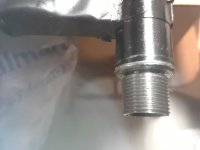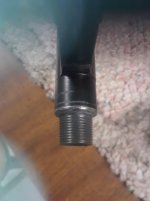I used a pipe thread cutter to remove a 1/2" long barrel shroud from in front of the front sight post of a Saiga 7.62 x 39mm Rifle barrel, in order to thread the end of the barrel for a muzzle device. The Saiga Rifles don't come with muzzle devices, and mine didn’t have threads pre-installed, so you have to thread the end of the barrel yourself.
The muzzle device calls for a 14 x 1LH thread. When I removed the barrel shroud, the tube cutter wheel did cut into the OD of the barrel slightly deeper than the depth of the shroud itself. The groove around the OD of the barrel is probably about the width of a dime.
The barrel diameter mics out as follows:
Barrel diameter =.565”
Diameter of the Tube Cutter Groove = .489”
So, the difference between the OD of the barrel diameter and the OD of the groove diameter = .076”
A 14mm x 1 thread has a .497” (thread minor diameter), so when you factor-in the.489” (Tube Cutter groove diameter) that equals .008.” So, I should have about .008” of excess barrel material above the minor diameter of the threads.
So, will cutting accidentally into the barrel slightly with the tube cutter affect the integrity of the barrel?
I assume the pressures at the end of the barrel would be significantly less by the time the gases are expelled through the piston mechanism, etc. I also assume the muzzle device itself will provide quite a bit of additional strength when screwed down and completely covering the tube cutter groove. I’ll be using some Rockset to secure the muzzle device to the threads so the muzzle device doesn’t move.
The muzzle device calls for a 14 x 1LH thread. When I removed the barrel shroud, the tube cutter wheel did cut into the OD of the barrel slightly deeper than the depth of the shroud itself. The groove around the OD of the barrel is probably about the width of a dime.
The barrel diameter mics out as follows:
Barrel diameter =.565”
Diameter of the Tube Cutter Groove = .489”
So, the difference between the OD of the barrel diameter and the OD of the groove diameter = .076”
A 14mm x 1 thread has a .497” (thread minor diameter), so when you factor-in the.489” (Tube Cutter groove diameter) that equals .008.” So, I should have about .008” of excess barrel material above the minor diameter of the threads.
So, will cutting accidentally into the barrel slightly with the tube cutter affect the integrity of the barrel?
I assume the pressures at the end of the barrel would be significantly less by the time the gases are expelled through the piston mechanism, etc. I also assume the muzzle device itself will provide quite a bit of additional strength when screwed down and completely covering the tube cutter groove. I’ll be using some Rockset to secure the muzzle device to the threads so the muzzle device doesn’t move.
Last edited:


